Growing Carrots in Containers from Seed to Harvest
March 24th, 2021 | Categories
Growing carrots at home in containers or pots is a great way for you to grow your own if garden space is at a premium, or perhaps there’s no garden at all. Carrots can even be grown on a decking area, patio, or a balcony. Better still, carrots are one of the easiest vegetables to take from seed all the way to harvest, and therefore your plate. Fresh carrots are crunchy, tasty, and all round delicious. And they’ll be even better because you grew them yourself.
You’re in good company with carrots. It is up there as one of Britain’s most popular vegetable. So many gardeners and allotment growers grow carrots. Nationally, Britain plants more than 22 billion carrot seeds per year and the average person will eat more than 100 whole carrots annually across a variety of dishes from soup to pie to cake! The versatility of carrots as ingredients combined with the ease of growing them makes it a no brainer for most people who enjoy growing their own vegetables. There are so many varieties of carrots you don’t see in supermarkets. From big, to small, from long to stumpy, reds, oranges, yellows, even purple carrots, that you just can’t get unless you grow them by yourself.
If you want to grow your own carrots in containers at home, then this guide will give you a good steer on what to do from the preparation to the tools needed, through to planting and on to harvest. It will take you through all the steps and considerations. We have covered how to grow carrots in the ground in another guide, you can read it here if that’s the method you want instead. But we’ll let you in on a secret, growing carrots in containers is easier than growing in the ground! So, if it’s your first venture into growing your own carrots in containers then have no fear, we’ll keep you right. Let’s get started.
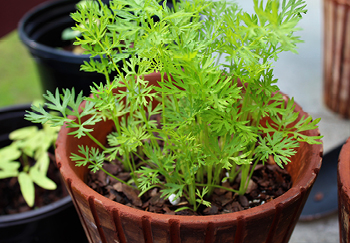
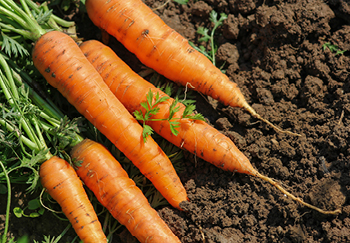
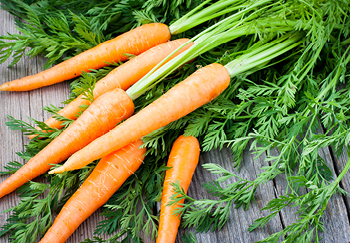
Why Grow Carrots in Containers at Home?
Carrots are quite a robust vegetable, quick and easy to grow too, so even if you are the beginner of beginner vegetable growers you shouldn’t have too much trouble successfully growing them from seed in containers. Carrots also have a small footprint, so they won’t take up too much and that’s why they do so well in containers. Container growing is also easier than ground growing. You can control factors such as poor soil, weeds (there are none) and avoid pest more easily. They are also really good for you. Carrots are rich in antioxidants and are packed with fibre, vitamins, and minerals. There are many studies about the health benefits of carrots, from helping our immune systems, bones, and more. There are even studies that show carrots may help to prevent several types of cancers. Interestingly, carrots are one of the very few vegetables that are more nutritious when cooked.
Another reason, store-bought carrots do not compare. The carrots available in supermarkets may be cheap, but they’ll never be able to match the freshness, or the flavour, or even the wonderful crunch of homegrown carrots, right from your container. Store-bought carrots are grown for their longevity at the cost of other things like flavour, size and texture. With homegrown carrots you can achieve better quality vegetables that will last as long as you need them, that are also better for you. Need we say more?
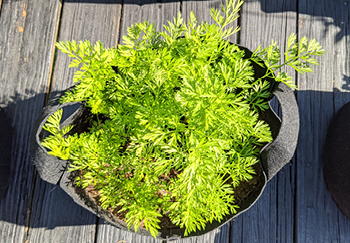
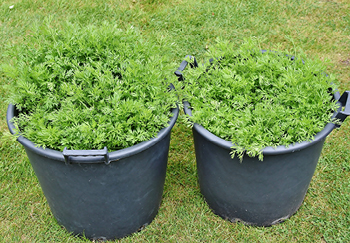
What Variety of Carrots Should You Grow in Containers?
There are quite a few varieties of carrots to grow. More than you might think. Carrots come in an array of sizes and even colours. Thankfully, they are all super easy to grow for a gardener of any experience, and they’ll generally keep for several months no matter the variety, but only if you store them correctly. The specific variety you will want will depend on the use case. Think to yourself what you want carrots for, whether it be soups, salads, general cooking, all-rounders that are good for everything, colourful beyond just orange, big, small. Consider all that and you’ll narrow in on the best types for you in no time.
However, there’s one overarching consideration to keep in mind when it comes to container growing carrots: the depth of your container. Chances are you’re not going to have container large or deep enough to accommodate a depth of 50ish centimetres of soil, so, this will affect the types of carrots you can grow. Thankfully, there are plenty of varieties of carrot that are a bit shorter, but still fat enough to give you a good crop and make growing them worthwhile. It just means you can’t grow the largest of varieties.
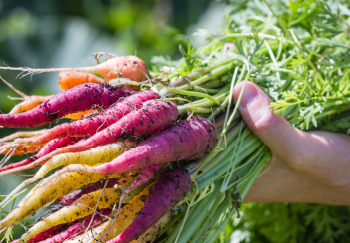
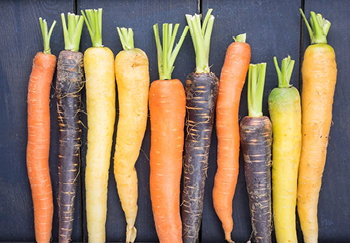
Short vs Long-Rooted & Earlies vs Maincrop Carrots
Carrots are generally classified as short- or long-rooted, and early or maincrop type. Don’t panic at these terms, it’s all very simple, and necessary to consider when it comes to purchasing the carrots you want. You would want to purchase seeds thinking it’s the long-rooted variety only to find short stumpy carrots when it comes to harvest. Basically, short-rooted carrots are shorter and sometimes stumpier looking than their long-rooted counterparts. Long-rooted carrots are more akin to the ‘classic’ carrot we are accustomed to. Carrots are also classified as being either early or maincrop. Early varieties of carrot are generally sown in spring making them ready to harvest in about 8-10 weeks, usually from early summer to midsummer. Early carrots are generally smaller in size and typically eaten soon after harvesting.
This is in comparison to maincrop varieties of carrot which are generally sown towards the middle to end of spring, taking about 14-16 weeks to come to harvest. Because maincrop varieties are in the ground longer they are generally larger and produce a larger harvest. Maincrops are typically harvested in late summer or early autumn. Whatever variety of carrot you wish to grow just be sure of their specific type, when to sow, when to harvest, and any individual needs or characteristics they may have. As you will be growing your carrots in containers or pots remember to consider the size of your containers when selecting your seeds. Don’t pick ones that grow too deep!
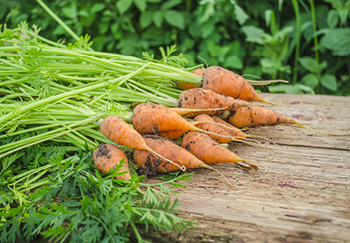
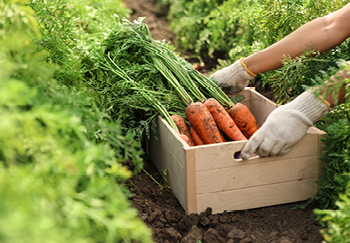
Varieties to Try Growing in Containers
If you thought a carrot was just orange, and well, ‘a carrot’ or a ‘baby’ carrot, you’d be forgiven as there’s not much choice for us on the supermarket shelves. But as with all vegetables, there are so many more varieties out there, and therefore choices, that you can only really experience if you grow them yourself. This list below is just a small selection of the many varieties of carrot you can choose to grow in containers:
Amsterdam Forcing (short & early)
This is a very popular, short-rooted, early variety of carrot with blunt ended roots. It is suitable for container growing or when space is restricted. The carrots develop a good orange colour quickly and have a great, sweet flavour. They are quite good for storing and even freezing.
Early Nantes 2 (short & early)
Originating from Nantes, this is an early variety of carrot, short-rooted, good for container growing or when space is tight. These carrots develop a deep orange colour with a good crunch, and sweet flavour. Also good for storing and freezing.
Chantenay Red Cored (short & maincrop)
This is an early maincrop variety producing small cored stumpy carrots. They have a deep orange colour and very good flavour. They also have the added bonus or storing well. Definitely a contender for container growing.
Paris Market Round (short & early)
For shallow containers there is the Paris Market Round variety. This variety produces small round carrots that have a deep orange colour, a lovely, sweet aroma and great flavour. It crops quite quickly too.
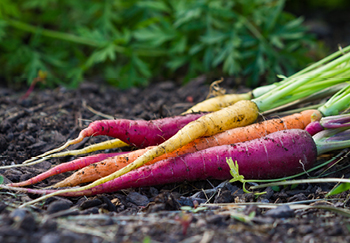
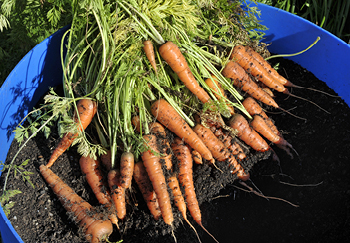
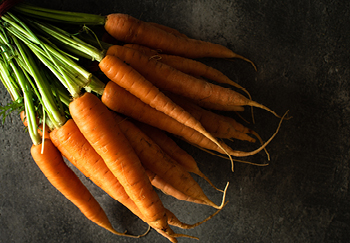
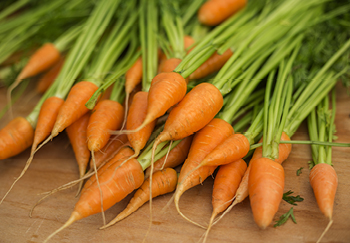

General Growing/Harvesting Timescale for Carrots
As we covered earlier, when it comes to planting your carrots, there are Early and Maincrop varieties. Early varieties are harvested sooner when compared to maincrop carrot varieties.
Based on a rough start date sometime mid to late March/early April:
- Early carrots roughly 8-10 weeks days after planting to mature and should be ready to start harvesting in mid to late June.
- Maincrops take the longer to mature, at roughly 14-16 weeks or around mid to late August.
Please note, this is just a rough guide and you should research individual growing and harvesting timelines for your chosen varieties of carrot. Weather and growing conditions will also be factors to consider. If you are in a colder region of the UK on average, it might pay to wait a bit longer to plant. You could sow your seeds all the way up until July with minimal issue. If planting in a warm place, maybe inside a growing shed, greenhouse, or balcony with lots of sun, then you should be able to get going sooner. Consider the factors that apply to you.
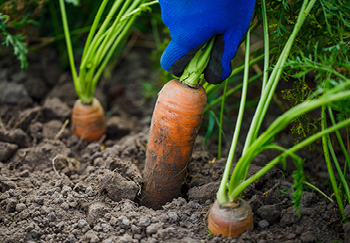
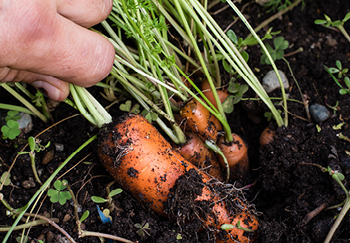
How to Start Growing Carrots in Containers
Now you know more about carrots you’re ready to get started preparing to grow your own at home in containers. It pays to know what to do in advance so please read through our guide, get up to speed, and then when you’re ready to go, get started! Remember, you’ll be starting off from carrot seeds and will need to consider and prepare your materials and site ahead of time.
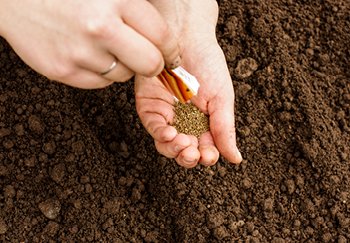
What You Will Need
When it comes to growing your own fruit or vegetables, preparation is the key to success. Before starting anything, gather some necessary items and materials:
Containers/Pots
For a better crop, opt for multiple containers. Depth is the most important consideration and the minimum needed to successfully grow is roughly 20cm to 30cm. Ensure the pot has good drainage otherwise overly damp or waterlogged soil can lead to rot.
Carrot Seeds
Purchase your chosen carrot seeds remembering the key points we covered earlier.
Compost and Soil
You can easily purchase good quality potting soils from any garden centre that will do the job nicely. The great thing is these are guaranteed to be free of any pests or disease, or debris that could upset and destroy your crop.
Hand Fork
For digging and loosening the soil as you pour it into the containers. The soil should be nice and loose to make it drain well and also to allow your carrot seeds to grow well.
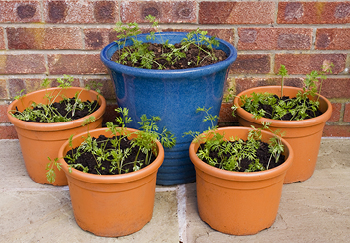

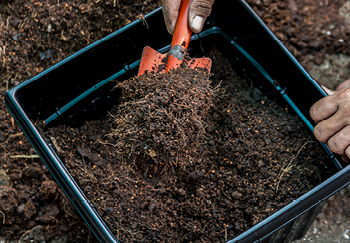
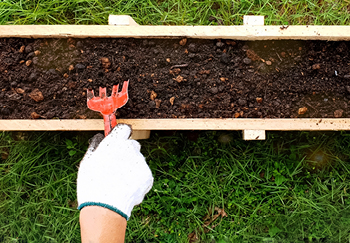
Container Placement & Preparation
Carrots require an open, sunny-ish spot, and fertile, well-draining soil. When choosing a spot for your container in the garden, patio, or balcony. Carrots are quite shade tolerant, but they do need some sun. Only do this in spring when the risk of nightly frosts has passed and there’s a daytime temperature over 10°C. If you have access to a greenhouse then you will be able to do this sooner in the season so long as it is frost free.
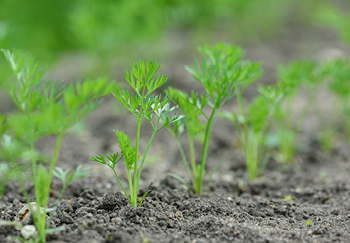
Sowing Seeds in Your Container
Just before sowing, water the soil in your container. Next, in the soil create shallow holes about 2cm to 3cm deep, and about 5cm to 7cm apart. Place three carrot seeds in each hole then fill over again with the soil. Naturally, the size of your container will dictate how many plants you can grow so if you want a plentiful crop use multiple containers. Try not to overseed the holes or the entire container, as it can lead to overcrowding and over competition for nutrients in the soil. It can also mean you will have to take some of the young plants away, and the smell produced whilst doing this can attract a certain pest that loves carrots. So, plant well, but spaciously, and you won’t need to do that later.
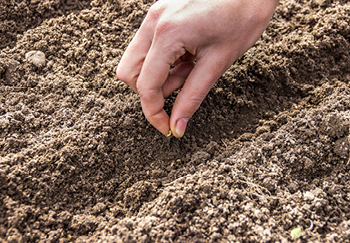
Growing
Carrots don’t require that much care. Water is what they really need especially when it comes to container growing. Over the coming weeks continue to keep an eye on things and water regularly but minimally, a little bit more in drier or warmer periods. The goal is not to soak the soil or make it soggy, but keep it damp. Carrots are drought resistant so too much water can cause them to split which can ruin the flavour and make them nigh on unpeelable too. If your carrot happens to show a little above the soil, or if their stems lean, just earth them up again otherwise, they can turn green. As they are growing you can use a fertiliser but be careful of how much you use. It is likely you’d only need to use it once and sparingly. A general-purpose fertiliser will do the job but carrots main need is water.
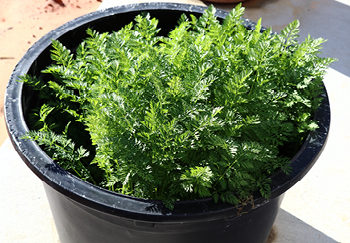
Harvesting
As mentioned earlier, when to harvest from your container will depend on your chosen carrot variety, weather and growing conditions. But when the exciting time comes to harvest, water the soil first because the most ground will make it easier to pull them up. Once moist enough, start pulling them up! If you are unsure if they are ready, you can pull one or two as a test before pulling the rest.

Storing Them
Carrots generally store well and will last up to four months. Choose only the best carrots cleaning them of any remaining soil and cutting their leaves. Disregard any that show early signs of rot or other imperfections. When you’ve chosen your carrots put them in layers in a bucket or box filled with damp sand, then place the bucket/box somewhere cool and dark. Carrots can also be stored in the fridge but for a shorter period. Clean and remove the tops of any carrots you wish to store and place them in the fridge. They should last for three to four weeks. Some carrots will be fine frozen so prepare them in the same way as above if storing in the fridge then place them in your freezer. If you want to freeze them do this as soon as you can to preserve their nutrients and flavour. Thaw thoroughly before use.
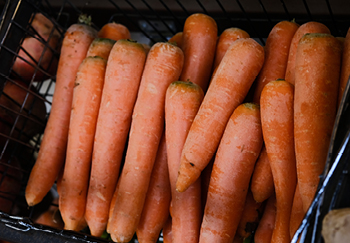
Watch Out for the Carrot Fly
Carrots are generally a pretty hardy and easy plant to grow if you do it right. However, they have a pest that really loves them. The Carrot Fly. This pest is drawn to the carrots by the smell of crushed foliage when thinning the plants out during growing. But remember what we said earlier? Space your carrots out enough in the container and you won’t need to thin them out, thereby greatly reducing the risk of attracting these flies.
Another way to ensure carrot fly stay well clear is to use a barrier. Placing a shield of thin mesh or clear polyethene at least three to four feet high will prevent them easy access, as they are typically a low-flying insect. Of course, you may be growing in a greenhouse or grow shed or even your home, in which case access to the carrots would be much harder, probably eliminating the risk altogether. Additionally, there are some fly resistant varieties you can grow too. Prevention is better than cure with these pests, so if you have them it’s likely your crop is going to be ruined.


Your Very Own Home-Grown Carrots
And we’re done! Does it seem easy? Well, it is! There’s nothing better than the sweet, fresh and crunchy goodness of carrots you’ve grown by yourself. Reading through this guide has hopefully shown you just how easy it is to grow carrots in containers even when space is at a premium around your property. We hope you’ll give it a go.

Useful Links
- Shop Online for Carrot Seeds
- Top 5 Fast Growing Vegetables (Video)
- Growing Carrots from Seed to Harvest (Article)
- Growing Onions from Seed to Harvest (Article)
- Growing Potatoes from Planting to Harvest (Article)
- Growing Chillies from Seed to Harvest (Article)
- Guide to Growing Tomatoes in Pots (Article)
- Grow Your Own Herbs (Article)
- Grow Your Own Strawberries (Article)






